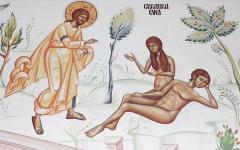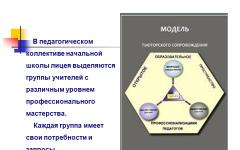Lesson on the surrounding world on the topic "Structure and diversity of animals", grade 3-B, program "Planet of Knowledge" Miroshnikova Galina Lavrentievna, primary school teacher Objectives: generalize and systematize knowledge about the structure and diversity of animals; identify the feeding habits of animals; show the adaptability of animals for obtaining and eating food; develop visual, figurative and logical thinking, imagination, creativity, and the ability to conduct comparative analysis; broaden the horizons of students, cultivate a love for animals. Equipment: presentation (Appendix 1), media projector, cards for group work, work in pairs, differentiated work. Lesson progress I. Organizing students' attention. II. Reinforcing the material covered. 1. Introductory speech by the teacher.< Слайд 2 >There is just a temple, There is a temple of science, And there is also a temple of nature - With flowers stretching out their hands Towards the sun and winds. It is holy at any time of the day, Open to us in the heat and cold, Come here, Be sensitive with your heart, Do not desecrate its shrines. S. Smirnov 2. Statement of the topic and purpose of the lesson.< Слайд 3 >, < Слайд 4 >3. Intellectual marathon. Target setting: name the group of the animal kingdom, give them a brief description. a) They have six legs, organs of touch - hairs located throughout the body. (Insects)< Слайд 5 >b) Forelegs - wings. (Birds)< Слайд 6 >c) Only they have an external ear - the auricle. (Mammals)<Слайд 7-8 >4. Differentiated work. a) What determines the method of movement of an animal? Find the answer to the question in the text. Animals move in different ways. The methods of movement of animals depend on the structure of their limbs (legs and wings) and their habitat. b) Why does the frog jump, but the toad only walks? Think about it. (The frog jumps because its hind legs are longer and stronger than those of the toad.) 5. Work in groups. Target setting: fill out the table; Indicate with a “+” sign the property that this group of animals has.< Слайд 9-20 >Property Fish Amphibians Reptiles Cover of scales Bare skin Respiratory organs - gills Respiratory organs - lungs Limbs - fins Limbs - legs Live on land Live in water 6. Work in pairs. Target setting: What temperature will a snake, lizard, tit, cat have at ambient temperature + 5.< Слайд 23-24 >snake +5 tit + 40 frog + 38 cat + 5 7. Research work. (Students work in groups)< Слайд 25 >Study. How do animals eat? Problem: “What does animal nutrition depend on?” Target setting: read the texts, prepare answers according to this plan. Insects. Many beetles feed on plants. They have strong jaws that can tear off parts of plants. Butterflies feed on flower nectar, which they obtain using a long, spirally twisted proboscis. When sucking nectar, the butterfly straightens its proboscis and launches it into the flower. Ladybugs eat aphids, small insects that live on plant leaves. Birds. The sparrow has a short, high and very strong beak, with which it easily bites through hard seeds and grains. The starling has a thin and sharp beak. With the help of such a beak, it easily pecks small insects from the ground or plants. The swallow has a short, wide-opening beak, which allows it to catch insects right in the air. The eagle has long, sharp talons and a sharp, downturned beak. Thanks to this, they can capture, kill and tear apart large prey. Mammals. The beaver and squirrel have well-developed incisors and molars. They bite off food with their incisors, and grind it thoroughly with their molars. Their incisors are sharp and large. They do not become dull even from very hard food - tree trunks, nut shells. A mole and a bat have almost identical teeth. They only allow you to grab and crush prey. The lion has large sharp fangs and claws. With their help, he can grab and tear large animals. 8. Review of research work. 9. Teacher’s story about herbivores, carnivores, omnivores. Slide< 26-29 >Animal food is varied. There are very few animals that prefer only one type of food. Many more animals use different food. Animals that eat mainly plants are called herbivores. Plant foods are also varied. Therefore, among herbivorous animals, herbivores, granivores, and folivores are distinguished. Animals that use other animals for food are called carnivores. Among carnivores, insectivores and carnivores are especially distinguished. Animals that eat equally plant and animal foods are called omnivores. III. Lesson summary. Return to the goal.< Слайд 30 >- Perhaps the knowledge you acquired in the lesson will help you come closer to understanding the living language of nature and you will say: “The world is beautiful!”< Слайд 31 >IV. Homework assignment. Information search (students use an encyclopedia about animals)
Sections: Biology, Primary school
Class: 3
Goals:
- generalize and systematize knowledge about the structure and diversity of animals;
- identify the feeding habits of animals; show the adaptability of animals for obtaining and eating food;
- develop visual, figurative and logical thinking, imagination, creativity, and the ability to conduct comparative analysis;
- broaden the horizons of students, cultivate a love for animals.
Equipment:
- CD with presentation (Appendix 1),
- media projector,
- cards for group work,
- work in pairs,
- differentiated work.
Lesson progress
I. Organizing students' attention.
II. Reinforcing the material covered.
1. Introductory speech by the teacher. < Слайд 2 >
There is just a temple
There is a temple of science
And there is also a temple of nature -
With flowers reaching out
Towards the sun and winds.
He is holy at any time of the day,
Open to us in the heat and cold,
Come in here
Be a little hearty
Do not desecrate his shrines.
S. Smirnov
2. Statement of the topic and purpose of the lesson. < Слайд 3 >, < Слайд 4 >
3. Intellectual marathon.
Target setting: name the group of the animal kingdom, give them a brief description.
a) They have six legs, organs of touch - hairs located throughout the body.
(Insects) < Слайд 5 >
b) Forelegs - wings.
(Birds) < Слайд 6 >
c) Only they have an external ear - the auricle.
(Mammals) <Слайд 7-8 >
4. Differentiated work.
a) What determines the method of movement of an animal?
Find the answer to the question in the text.
Animals move in different ways. The methods of movement of animals depend on the structure of their limbs (legs and wings) and their habitat.
b) Why does the frog jump, but the toad only walks? Think about it.
(The frog jumps because its hind legs are longer and stronger than frogs.)
5. Work in groups.
Target setting: fill out the table; indicate with a “+” sign the property that this group of animals has . < Слайд 9-20 >
| Property | Fish | Amphibians | Reptiles |
| Shroud of Scales | |||
| Bare skin | |||
| Respiratory organs - gills | |||
| Respiratory organs - lungs | |||
| Limbs - fins | |||
| Limbs - legs | |||
| Live on land | |||
| Live in water |
6. Work in pairs.
Target setting: What temperature will a snake, lizard, tit, cat have at ambient temperature + 5 . < Слайд 23-24 >
- snake +5
- tit + 40
- frog + 38
- cat + 5
7. Research work. (Students work in groups) < Слайд 25 >
Study. How do animals eat?
Problem: “What does animal nutrition depend on?”
Target setting: read the texts, prepare answers according to this plan.
1. Name of the animal.
2. This animal eats...
3. They help him find food...
4. An animal eats food using...
Insects.
Many people eat plants beetles. They have strong jaws that can tear off parts of plants.
Butterflies feed on flower nectar, which is obtained using a long, spirally twisted proboscis. When sucking nectar, the butterfly straightens its proboscis and launches it into the flower.
Ladybugs eat aphids, small insects that live on plant leaves.
At the sparrow's a short, high and very strong beak, with which it easily bites through hard seeds and grains.
At the starling's the beak is thin and sharp. With the help of such a beak, it easily pecks small insects from the ground or plants.
The swallow has a short, wide-opening beak, which allows it to catch insects right in the air.
The eagle has long, sharp talons and a sharp, downturned beak. Thanks to this, they can capture, kill and tear apart large prey.
Mammals.
Beaver and squirrel well developed incisors and molars. They bite off food with their incisors, and grind it thoroughly with their molars. Their incisors are sharp and large. They do not become dull even from very hard food - tree trunks, nut shells.
A mole and a bat have almost identical teeth. They only allow you to grab and crush prey.
The lion has large sharp fangs and claws. With their help, he can grab and tear large animals.
8. Review of research work.
9. Teacher’s story about herbivores, carnivores, omnivores.
Slide< 26-29 >
Animal food is varied. There are very few animals that prefer only one type of food. Many more animals use different food. Animals that eat mainly plants are called herbivores. Plant foods are also varied. Therefore, among herbivorous animals, herbivores, granivores, and leaf-eaters are distinguished.
Animals that use other animals for food are called carnivores.
Among carnivores, insectivores and carnivores are especially distinguished.
Animals that eat equally plant and animal foods are called omnivores.
III. Lesson summary.
Return to goal . < Слайд 30 >
Thought about it
I was surprised
Perhaps the knowledge you acquired in the lesson will help you come closer to understanding the living language of nature and you will say: “The world is beautiful!”< Слайд 31 >
IV. Homework assignment.
Information search (students use an encyclopedia about animals)
Diversity and relationships of animals
Features of animals. Animals, like all other living organisms, breathe, eat, grow, reproduce, and have irritability.
However, animals, as we know, have very significant differences from other groups of living organisms, which, as a rule, are characteristic only of this group. Unlike plants, animals feed on ready-made organic substances. Therefore, in natural communities they play the role of consumers of organic matter. Most animals are capable of movement. Plants and fungi lead an attached lifestyle. Unlike plants, which grow throughout their lives, most animals grow only in the early stages of development.
Most animals have complex organ systems: musculoskeletal, digestive, respiratory, circulatory, nervous, excretory and others, which plants, fungi and bacteria do not have.
Variety of animals. Animals - the most diversegroup of organisms on Earth.
In the present The current time on the planet isabout 2 million animal species. Painthe majority of them are insectswashed ( butterflies, mosquitoes, beetles, flies... ). About 130 thousand species of mole are known Lyuskov: snails, slugs, pearl barley, squid . Much more modestdiversity in fish - only 25 thousand speciesDov, birds - 8,600 species. And the mammalsmelting - only about 4 thousand species.
Animals vary in sizeram. For example, the giantblue whale body weight reaches 150 tons (weightthe tongue of such a whale is equal to the mass of a smallwhat an elephant), and ciliate slipper can only be discovered using microscope
Diversity of environments and habitats. On Earth, there are a wide variety of conditions for the life of organisms.
 Animals live in various environments (in water and on land, in soil, air, inside plants, other animals and humans).
Animals live in various environments (in water and on land, in soil, air, inside plants, other animals and humans).
Basic habitat animals - aquatic, ground-air and soil. Each of them is inhabited by different animals.
Animals in any habitat do not live everywhere, but occupy the most favorable areas for them. They are called habitats (or habitat) of animals. For example, nightingales found in damp and shaded areas of the forest. Pike in rivers they prefer places with slow currents (pools, pools), overgrown near the banks.
 Organisms in nature do not live in isolation from each other, but in species.
Organisms in nature do not live in isolation from each other, but in species.
A species is a collection of similar individuals capable of interbreeding to form fertile offspring. A species consists of many individuals that reproduce, disperse, and maintain unity in the struggle for existence. The distribution area of a species is called habitat .
For example, white hare found throughout the taiga zone of Eurasia. The habitat of this species is taiga forests. Each forest contains a group of white hare individuals, isolated from other such groups. All individuals of the same species inhabiting a certain territory form population . The sum of all populations constitutes the species.
Animal adaptations. Animals are well adapted to living in certain conditions. Their structure always corresponds to their habitat and lifestyle.
So, studying body shape animals, we will certainly note that many swimming animals have a streamlined body shape (fish). Digging soil animals often have a worm-like body shape ( earthworms).
 One of the characteristic features of animals is clear symmetry of the body. By type of symmetry
There are radially symmetrical and bilaterally symmetrical animals.
One of the characteristic features of animals is clear symmetry of the body. By type of symmetry
There are radially symmetrical and bilaterally symmetrical animals.
Radial symmetry is characteristic of animals leading a sedentary lifestyle. Several imaginary planes can be drawn through their body, each of which divides the animal into halves that are mirror-like to each other. Bilaterally symmetrical animals are actively moving organisms. Through their body, you can mentally draw only one plane, which divides the animal into two identical halves. These animals have front and back, right and left parts of the body, paired organs (so, frogs a pair of eyes, etc.).
Various in animalsbody coverings . For example, a frog has bare, mucus-covered skin. With such skin it is good to live in humid places. U perch the skin is covered with scales. This is not only a protective device. The structure of the fish's scales and the slippery film on its surface contribute to the speed of sliding forward. Leather pigeon covered with feathers dogs- wool. Each of the listed features was developed during the development of the species as an adaptation to the environment and way of life.
Various in shape and structure locomotion organs animals - legs, wings, flippers, fins. And some animals have no organs of locomotion at all ( coral polyps etc.).
The origin of organisms, their adaptability and diversity. One of the most interesting and important questions in biology is the question: what is the reason for such a diversity of living organisms on our planet? After all, there are about 2 million species of animals alone. How can one explain their amazing adaptability to living conditions? It is difficult to find a place on Earth where some creature does not live.
The most famous theory explaining the diversity of animals on Earth can be found in the book of the great English biologist “The Origin of Species by Means of Natural Selection” (1859). In it, Darwin showed how, in the process of historical development (evolution), organisms developed various adaptations to the environment, habitat and lifestyle that they lead.
The essence of natural selection among organisms is that among millions of nascent individuals, the most adapted remain alive... Naturally adapted to the habitat, to the conditions in which a particular species lives. In the future, they will pass on their traits, which turned out to be useful, to their descendants.
Thus, from generation to generation, as a result of natural selection, species change in the direction of increasing adaptability to environmental conditions. Darwin argues that the diversity of living nature is formed through natural selection.
Darwin's teachings prove that the driving forces of evolution - the development of nature - are found in nature itself. One of the main places among them belongs to natural selection.
The relationship between animals, when some of them hunt, kill others and feed on them, is called predation.
 Predators
- This falcon
, pursuing pigeon;
bug
attacker caterpillar;
pike
, catching roach
. Animals that are hunted by predators are theirvictims
. Predators have devices for hunting - this is a hunting webspider
, powerful teeth wolves
or tigers
and sharp claws and beakowls
. Victims have their own adaptations to hide or run away from a predator, to protect themselves from it. That and fast feetantelope
, and big ears hare
, and protective coloringchameleon
, and needles hedgehog.
Predators
- This falcon
, pursuing pigeon;
bug
attacker caterpillar;
pike
, catching roach
. Animals that are hunted by predators are theirvictims
. Predators have devices for hunting - this is a hunting webspider
, powerful teeth wolves
or tigers
and sharp claws and beakowls
. Victims have their own adaptations to hide or run away from a predator, to protect themselves from it. That and fast feetantelope
, and big ears hare
, and protective coloringchameleon
, and needles hedgehog.
Predators play an important role in nature - they restrain the excessive reproduction of animals, culling the weak and sick.
 Animals that inhabit the same habitat or eat similar food enter intocompetitive relations
.
Animals that inhabit the same habitat or eat similar food enter intocompetitive relations
.
In a state of competition are, for example, animals -stoats And ferrets feeding mice And voles ; from birds - flycatchers And tits , competing with each other for suitable nesting sites. Each of the pair of competing species is at a disadvantage.
 In addition, animals also have mutually beneficial relationships -symbiosis
. This is beneficial for contact animals.
In addition, animals also have mutually beneficial relationships -symbiosis
. This is beneficial for contact animals.
So, hermit crab specially transplants it onto its shellsea anemone . It protects the hermit crab with its burning tentacles from attacks by enemies, and the hermit crab, by moving, allows the sedentary sea anemone to change hunting grounds and catch more prey.
Among animals there are also relationships that are beneficial for one species of animal and harmless for another. Such relationships are calledtenancy .
For example, in a holegroundhog variousinsects, toads, lizards . They bring neither harm nor benefit to the groundhog, and the groundhog provides them with its shelter.
Animals are the most diverse group of organisms on Earth. Animals have characteristic differences: they feed on ready-made organic substances, most can actively move, grow only in the early stages of development, most animals have clear body symmetry, and have complex organ systems. Animals live in different environments and habitats. Their structure corresponds to their habitat and lifestyle. This is the reason for such diversity of living organisms. In the process of historical development (evolution), organisms have developed various adaptations to the environment, habitat and lifestyle that they lead. From generation to generation, as a result of natural selection, species change in the direction of increasing adaptability to environmental conditions.
According to the theory of evolution, all species of living beings on Earth gradually, over many millions of years, developed from their single-celled ancestors. More complex organisms most likely arose from colonies of protozoa. This can be tracked if you study the main types of animals in more detail. Classification divides all creatures into species, families, orders, classes according to their structure and external characteristics that were acquired during evolutionary improvement.
New types were formed and organs appeared that the most ancient ancestors did not have. The initial stage of such progress can be observed in sponges. Coelenterates already have well-defined endoderm and ectoderm, as well as the rudiments of muscles. Higher types of animals are characterized by a complex structure of the nervous system and other organ systems. To understand evolution, it is necessary to consider in more detail their most important features.
Protozoa
These are microscopic creatures with a single-cell structure. Scientists know about 15 thousand species. Their body shape is different, from radiant-radial to asymmetrical. They often form complex colonies, allowing scientists to speculate how multicellular animal types arose. They are divided into classes, depending on the methods of movement and body structure.
Sponges
The most primitive multicellular organisms. They live most often in the sea. They are divided into 3 classes, depending on the composition of the skeleton. Their way of life is fixed. Other types of the Animal Kingdom contrast with them because sponges lack characteristic organs and tissues. There is an outer layer that protects the organism from the surface, and an inner layer consisting of special flagellar collar cells. Between them is mesoglea - sometimes a very massive group of cells, some of which form the skeleton.

Coelenterates
The bodies of these animals consist of only two layers of cells that surround a body cavity called the intestine, with a single mouth opening. They have the rudiments of nervous and muscle tissue. Bloody and not. The lifestyle of coelenterates can be sedentary or freely mobile. They live, with rare exceptions, in sea water and form extensive colonies. This type includes jellyfish, corals, hydroid polyps and sea anemones.
Flatworms
Roundworms
Annelids
The bodies of such animals consist of separate segments. They have a circulatory system, a high ability to regenerate the rudiments of primitive limbs and a secondary body cavity. Other, more highly developed types of the Animal Kingdom were formed under the influence of these changes. Numerous representatives of the group of arthropods originated from marine annelids.

Shellfish
Animals whose soft body is usually protected by a shell. They have a highly developed nervous system and a secondary body cavity. Sense organs and a heart appeared - a muscle that pumps blood. In gastropods, the head can be distinguished. They live both in sea and fresh water, and on land.
Echinoderms
Inhabitants of the deep sea. The size of the largest representatives does not exceed 50 cm. The type includes the classes of sea urchins, stars, lilies and others. The lifestyle is immobile, due to which the five-ray symmetry characteristic only of echinoderms has been developed. Representatives of the type have a circulatory system and a mesodermic internal skeleton.

Arthropods
The types of animals are very broad. This group is precisely the type - the most diverse and richest in species. Characteristic features of the type are the presence of complex sensory organs in the form of dedicated appendages of the oral cavity - antennae, a clear division of the body into sections, limbs consisting of segments for more efficient movement. The development of arthropods passed from the extinct trilobites, a primitive group that is the ancestor of crustaceans and arachnids, to higher flying insects. Millipedes are considered a transitional link in the evolution of this type.
Chordata
The phylum includes species and classes that are diverse in their appearance, lifestyle, and habitat. The types of nervous system in animals are united by a tube formed on the dorsal part of the body, which is the center of all the numerous endings, which is protected by a notochord, a cartilaginous or bone rod, and a skeletal support. The development of representatives of various classes can be traced from larval chordates and skullless (lancelets) to complex primates characterized by high intelligence.
Fish
There are cartilaginous, lobe-finned or fleshy-lobed, and bony. Representatives of the first group have dense skin with placoid scales that are unique to them. The mouth is located on the underside of the body, there are no lungs or swim bladder, and the skeleton consists of cartilage.
Lobe-finned fish are divided into lungfish and lobe-finned fish. The latter are now represented by only one genus, living in the Indian Ocean. They are very similar to the ancestors of amphibians and are of particular interest to researchers who support the theory of evolution. Lungfish have both gills and lungs.

Bony animals are the majority of modern representatives of the fish class. They also have a hard skeleton; the skin is mostly covered with scales, but there are numerous exceptions.
Amphibians
As a rule, the larvae of these creatures breathe through gills and live in water. The adult has lungs and lives on land. The skin is moisturized and free of hair or scales. This class includes frogs, newts, toads, and salamanders.
Reptiles
The body is covered with scales, they live both on land and in water. In ancient times, this class dominated among the rest in numbers, but later mammals took the main place. They have a variety of sizes, body shapes, and lifestyles. Crocodiles, lizards, snakes, and turtles are representatives of reptiles.

Birds
They are anatomically close to reptiles, but they have acquired the ability to independently maintain their body temperature, regardless of environmental conditions. Birds have well-formed lungs, a four-chambered heart and wings, which allow most of them to move through the air.
Mammals
They are named so because of the presence of special glands, the secretion of which they feed their young. The body is usually covered with fur, they are warm-blooded, the limbs are brought under the body and turned forward. Higher mammals, primates, develop intelligence, which greatly contributes to survival.
All creatures are divided into 3 categories according to their feeding method:
. Herbivores. They eat exclusively plant foods - algae, herbs, leaves or fruits. For example, elk, deer, rabbit.
. Predators. They eat insects or the flesh of other animals. For example, frog, tiger, lynx.
. Omnivores. Depending on environmental conditions, they can eat both plant and animal foods. For example, bear, tit, wild boar.
Ocean of life
The ancient ancestors of modern creatures gradually emerged from the ocean, which became the cradle of life on Earth. This migration could take place in several ways - across the coast to land, into fresh water or into underground caves. Due to the dramatic change in the environment, the types of animal tissues changed and improved, which was necessary for survival. Some groups - whales, reptiles and birds - then returned to the sea, having gone through a long evolutionary path.

Now representatives of most classes live in or near the ocean. Many animal species, especially invertebrates, remain unchanged for millions of years and represent a valuable resource for study. The other major types of animals are considered relatively young, but their research has helped reveal genetic connections between seemingly different groups. This has a huge impact on the awareness of the unity of man with the surrounding nature and understanding of the enormous similarity of living beings.









